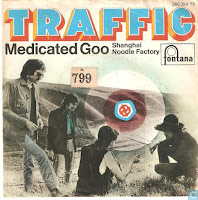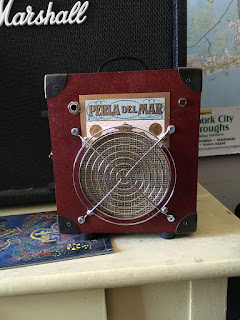Derek & the Dominos lone studio album,
Layla & Other Assorted Love Songs, was not a commercial or critical success upon its release in 1970. Producer Tom Dowd found himself at a loss regarding the lukewarm reception the album received, he was certain he had just poured sweat and tears into an amazing collection of songs. The album's initial thud at the sales counter is pretty hard to believe today considering it is now so universally beloved and considered a high point of Eric Clapton's career, featuring his most famous song, "Layla". But, like Orson Welles'
Citizen Kane or Vincent Van Gogh's
Starry Night, many of history's great artistic achievements take a while to sink in with the public and receive the acclaim they deserve.
It took me a while to come around
Layla as well. I have never been a huge Eric Clapton fan - his stinging Fender Stratocaster tone tires my ears. But you would think that the addition of Duane Allman, and what was essentially Delaney & Bonnie & Friends' touring band, would put this one in the win column immediately for me. But it didn't.
The story of
Layla has been recounted many times. Eric Clapton was in a bad place in the early 1970s. After years being hailed as a "Guitar God" (or
the Guitar GOD) while playing with John Mayall, The Yardbirds, Cream, and (briefly) Blind Faith, Clapton decided to retreat to the side of the stage. Meanwhile, the criminally underrated Delaney & Bonnie & Friends were playing rootsy folk, blues, and country music with a stellar band that included Bobby Whitlock, Jim Gordon, and Carl Radle. At the suggestion of Eric Clapton's good friend, George Harrison, Delaney & Bonnie opened for Blind Faith during its brief tour before quickly disbanding. Enamored with the down to earth music Delaney & Bonnie were making, Clapton decided retreat from the spotlight and take the lead guitar chair with them on their next tour as a sideman (one that had been briefly sat in by Harrison, Dave Mason, and eventually, occasionally Duane Allman).
 |
| Clapton, Bonnie & Delaney Bramlett, Harrison |
Delaney & Bonnie were always a critics and musicians' darling, but never a big seller. After the tour and a season of playing with them, Clapton used their bandmates for his first solo album (Joe Cocker also went on tour with essentially the same band - they were really good). Meanwhile, Clapton became famously enamored with best bud George Harrison's wife. The helplessness he felt for the love of his best friend's wife found itself into the song writing for his next album, which would not bear the guitarist's name, rather the band's new stage name in an attempt to give Clapton some anonymity. After a legendary meeting at an Allman Brothers concert, Duane Allman was invited to participate on the album as production was already underway.
 |
| Layla LP gatefold collage |
The original and covered music on
Layla is full of screams, cries, and pleas for a love that can't, or shouldn't, be. The energy is almost always hitting the ceiling - "Anyday", "Why Does Love Have To Be So Sad?", "Bell Bottom Blues", "Have You Ever Loved A Woman", "It's Too Late", and of course, "Layla", is almost too exhausting to listen to from start to finish. There are plenty of concept albums that sport a singular theme, but
Layla almost feels over-indulgent (anyone who has seen the album's interior photo collage can infer "over-indulgence" was the theme in the studio as well). I think that's why it never spoke to me too strongly, and much of it still doesn't (I still find "Why Does Love Have To Be So Sad" simple and childish, which it is kind of intended to be I suppose), but I've come to appreciate it much more in recent years. A degree of credit for my turn goes to the Tedeschi Trucks Band who have covered "Anyday" and "Keep On Growing" expertly (as well as a good amount of Joe Cocker's Mad Dogs & Englishmen material). I was surprised to find myself covering this song, but sometimes a project finds you. The lyrics are almost nonsense, but the music is so bouncy and hopeful, it is easily the most upbeat song on the album. This is also the final track to my second "album",
The Front Porch.
Derek & the Dominos didn't tour extensively. They performed only twice with Duane Allman whose time in the fold ended up being only a brief dalliance: though tempted to continue playing with one of his heroes, he quickly returned to his own band that was just beginning to catch fire. Eric Clapton's life would unravel in a downward spiral over the next few years before a late-1970s resurrection. The rest of the group, whose names are known primarily due to
Layla, essentially drifted after a brief reunion with Joe Cocker. Only Whitlock, who has recently returned to performing music, seemed to survive the industry intact - Gordon went mad and killed his mother, Radle drank himself to an early grave. Duane Allman died a year later in a motorcycle accident.
Layla and Other Assorted Love Songs is heralded as a masterpiece.
 After a successful stint backing up Linda Ronstadt, Glenn Frey and Don Henley decided to venture out and start their own country rock band, The Eagles. They were immediately successful, building on what The Byrds, Buffallo Springfield, The Flying Burrito Brothers, The Nitty Gritty Dirt Band, Crosby, Stills & Nash, and others had started before: smooth country-based ballads with pleasant harmonies. The genre didn't have the grit and sweat (or authenticity) of outlaw country of Johnny Cash or Waylon Jennings, nor the goofy polish of Nashville establishment acts like George Jones. These weren't cowboy campfire songs and the musicians weren't from The South, rather, the music was light and breezy like waves gently crashing on the desert. That style would go on to influence the sound of light 1970s AM rock (a sound expertly mocked in Documentary Now's Light & Breezy: The Story of the Blue Jean Committee, which took direct aim at The Eagles' inauthenticity).
After a successful stint backing up Linda Ronstadt, Glenn Frey and Don Henley decided to venture out and start their own country rock band, The Eagles. They were immediately successful, building on what The Byrds, Buffallo Springfield, The Flying Burrito Brothers, The Nitty Gritty Dirt Band, Crosby, Stills & Nash, and others had started before: smooth country-based ballads with pleasant harmonies. The genre didn't have the grit and sweat (or authenticity) of outlaw country of Johnny Cash or Waylon Jennings, nor the goofy polish of Nashville establishment acts like George Jones. These weren't cowboy campfire songs and the musicians weren't from The South, rather, the music was light and breezy like waves gently crashing on the desert. That style would go on to influence the sound of light 1970s AM rock (a sound expertly mocked in Documentary Now's Light & Breezy: The Story of the Blue Jean Committee, which took direct aim at The Eagles' inauthenticity).


























